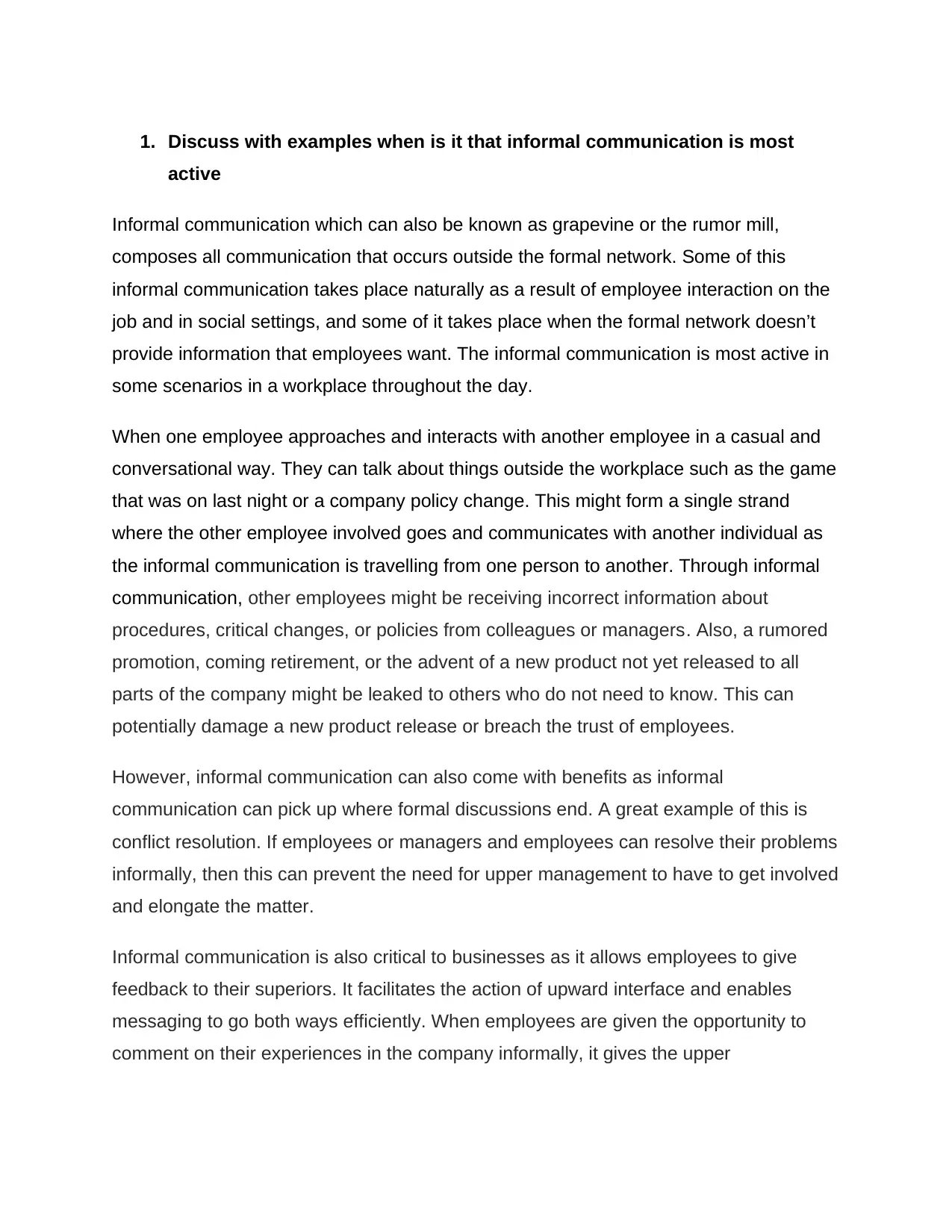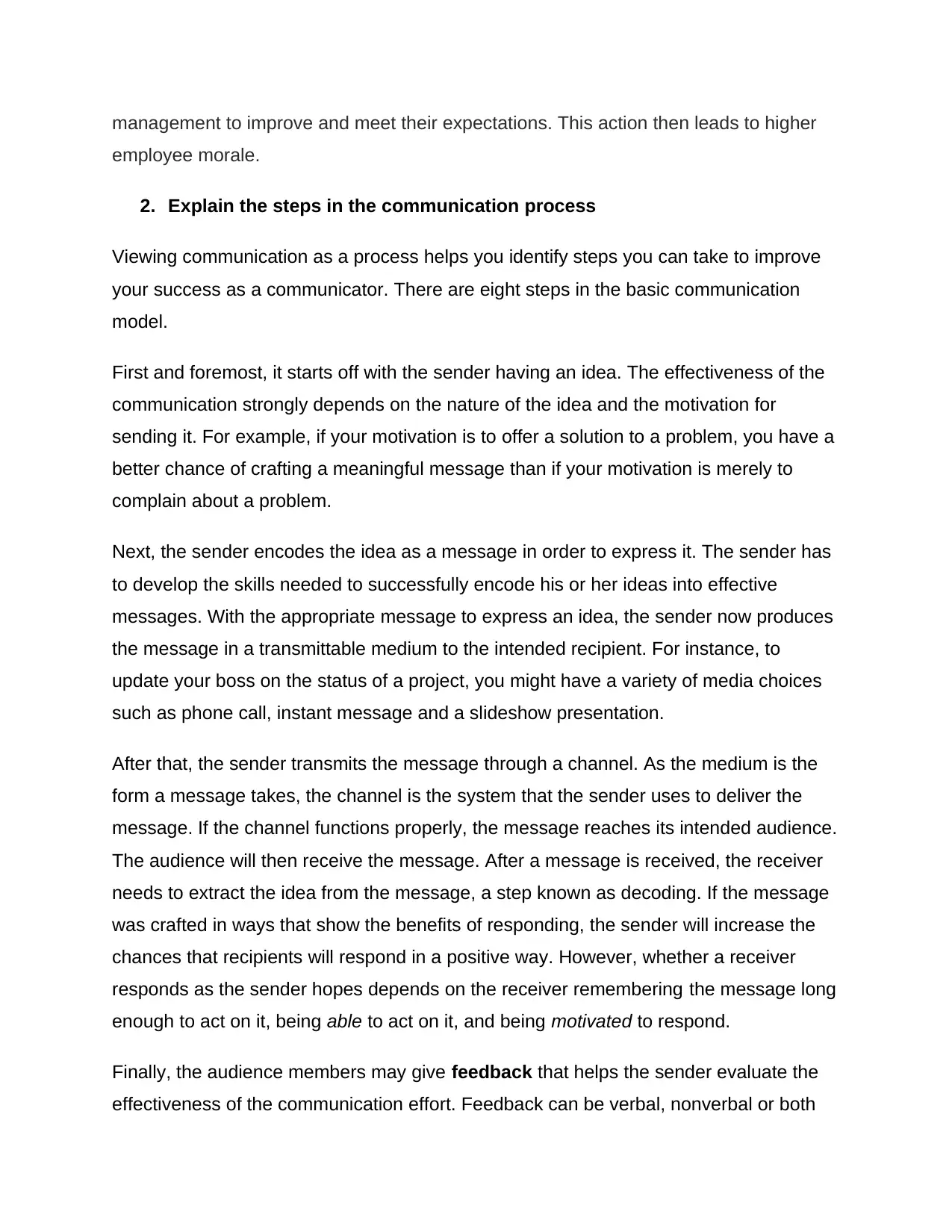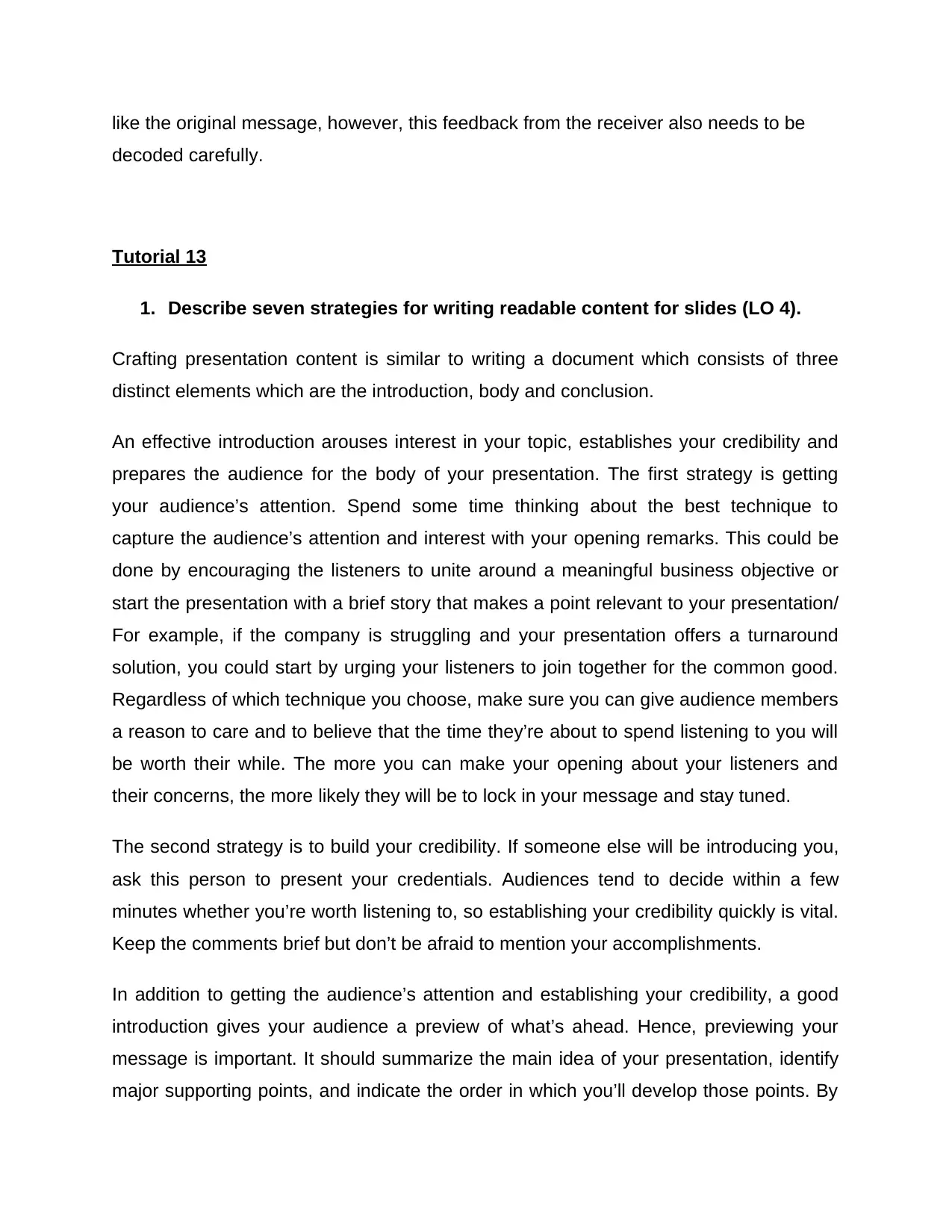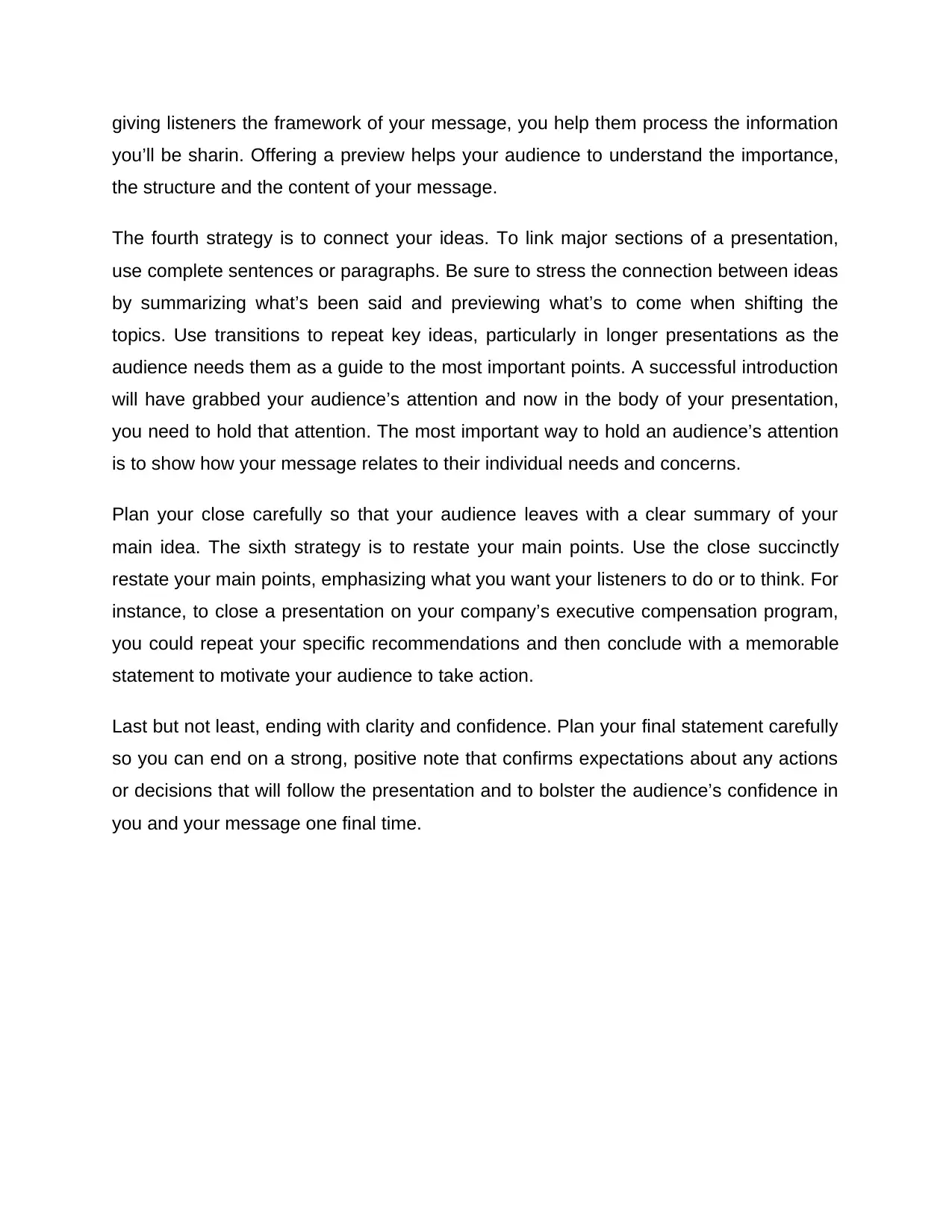Analysis of Informal Communication, Strategies, and Process
VerifiedAdded on 2021/07/30
|5
|1426
|158
Report
AI Summary
This report delves into the dynamics of informal communication within a workplace setting, exploring its active role in various scenarios. It provides examples of how informal communication, often referred to as the 'grapevine,' operates, including instances of casual employee interactions, the spread of rumors, and the potential for both positive and negative impacts. The report analyzes the communication process, outlining its eight key steps, from the sender's initial idea to the receiver's feedback. Furthermore, it describes strategies for crafting readable content for presentations, emphasizing the importance of capturing audience attention, building credibility, connecting ideas, and delivering a clear message. The report provides a comprehensive overview of effective communication practices, offering valuable insights for enhancing workplace communication and presentation skills.

1. Discuss with examples when is it that informal communication is most
active
Informal communication which can also be known as grapevine or the rumor mill,
composes all communication that occurs outside the formal network. Some of this
informal communication takes place naturally as a result of employee interaction on the
job and in social settings, and some of it takes place when the formal network doesn’t
provide information that employees want. The informal communication is most active in
some scenarios in a workplace throughout the day.
When one employee approaches and interacts with another employee in a casual and
conversational way. They can talk about things outside the workplace such as the game
that was on last night or a company policy change. This might form a single strand
where the other employee involved goes and communicates with another individual as
the informal communication is travelling from one person to another. Through informal
communication, other employees might be receiving incorrect information about
procedures, critical changes, or policies from colleagues or managers. Also, a rumored
promotion, coming retirement, or the advent of a new product not yet released to all
parts of the company might be leaked to others who do not need to know. This can
potentially damage a new product release or breach the trust of employees.
However, informal communication can also come with benefits as informal
communication can pick up where formal discussions end. A great example of this is
conflict resolution. If employees or managers and employees can resolve their problems
informally, then this can prevent the need for upper management to have to get involved
and elongate the matter.
Informal communication is also critical to businesses as it allows employees to give
feedback to their superiors. It facilitates the action of upward interface and enables
messaging to go both ways efficiently. When employees are given the opportunity to
comment on their experiences in the company informally, it gives the upper
active
Informal communication which can also be known as grapevine or the rumor mill,
composes all communication that occurs outside the formal network. Some of this
informal communication takes place naturally as a result of employee interaction on the
job and in social settings, and some of it takes place when the formal network doesn’t
provide information that employees want. The informal communication is most active in
some scenarios in a workplace throughout the day.
When one employee approaches and interacts with another employee in a casual and
conversational way. They can talk about things outside the workplace such as the game
that was on last night or a company policy change. This might form a single strand
where the other employee involved goes and communicates with another individual as
the informal communication is travelling from one person to another. Through informal
communication, other employees might be receiving incorrect information about
procedures, critical changes, or policies from colleagues or managers. Also, a rumored
promotion, coming retirement, or the advent of a new product not yet released to all
parts of the company might be leaked to others who do not need to know. This can
potentially damage a new product release or breach the trust of employees.
However, informal communication can also come with benefits as informal
communication can pick up where formal discussions end. A great example of this is
conflict resolution. If employees or managers and employees can resolve their problems
informally, then this can prevent the need for upper management to have to get involved
and elongate the matter.
Informal communication is also critical to businesses as it allows employees to give
feedback to their superiors. It facilitates the action of upward interface and enables
messaging to go both ways efficiently. When employees are given the opportunity to
comment on their experiences in the company informally, it gives the upper
Paraphrase This Document
Need a fresh take? Get an instant paraphrase of this document with our AI Paraphraser

management to improve and meet their expectations. This action then leads to higher
employee morale.
2. Explain the steps in the communication process
Viewing communication as a process helps you identify steps you can take to improve
your success as a communicator. There are eight steps in the basic communication
model.
First and foremost, it starts off with the sender having an idea. The effectiveness of the
communication strongly depends on the nature of the idea and the motivation for
sending it. For example, if your motivation is to offer a solution to a problem, you have a
better chance of crafting a meaningful message than if your motivation is merely to
complain about a problem.
Next, the sender encodes the idea as a message in order to express it. The sender has
to develop the skills needed to successfully encode his or her ideas into effective
messages. With the appropriate message to express an idea, the sender now produces
the message in a transmittable medium to the intended recipient. For instance, to
update your boss on the status of a project, you might have a variety of media choices
such as phone call, instant message and a slideshow presentation.
After that, the sender transmits the message through a channel. As the medium is the
form a message takes, the channel is the system that the sender uses to deliver the
message. If the channel functions properly, the message reaches its intended audience.
The audience will then receive the message. After a message is received, the receiver
needs to extract the idea from the message, a step known as decoding. If the message
was crafted in ways that show the benefits of responding, the sender will increase the
chances that recipients will respond in a positive way. However, whether a receiver
responds as the sender hopes depends on the receiver remembering the message long
enough to act on it, being able to act on it, and being motivated to respond.
Finally, the audience members may give feedback that helps the sender evaluate the
effectiveness of the communication effort. Feedback can be verbal, nonverbal or both
employee morale.
2. Explain the steps in the communication process
Viewing communication as a process helps you identify steps you can take to improve
your success as a communicator. There are eight steps in the basic communication
model.
First and foremost, it starts off with the sender having an idea. The effectiveness of the
communication strongly depends on the nature of the idea and the motivation for
sending it. For example, if your motivation is to offer a solution to a problem, you have a
better chance of crafting a meaningful message than if your motivation is merely to
complain about a problem.
Next, the sender encodes the idea as a message in order to express it. The sender has
to develop the skills needed to successfully encode his or her ideas into effective
messages. With the appropriate message to express an idea, the sender now produces
the message in a transmittable medium to the intended recipient. For instance, to
update your boss on the status of a project, you might have a variety of media choices
such as phone call, instant message and a slideshow presentation.
After that, the sender transmits the message through a channel. As the medium is the
form a message takes, the channel is the system that the sender uses to deliver the
message. If the channel functions properly, the message reaches its intended audience.
The audience will then receive the message. After a message is received, the receiver
needs to extract the idea from the message, a step known as decoding. If the message
was crafted in ways that show the benefits of responding, the sender will increase the
chances that recipients will respond in a positive way. However, whether a receiver
responds as the sender hopes depends on the receiver remembering the message long
enough to act on it, being able to act on it, and being motivated to respond.
Finally, the audience members may give feedback that helps the sender evaluate the
effectiveness of the communication effort. Feedback can be verbal, nonverbal or both

like the original message, however, this feedback from the receiver also needs to be
decoded carefully.
Tutorial 13
1. Describe seven strategies for writing readable content for slides (LO 4).
Crafting presentation content is similar to writing a document which consists of three
distinct elements which are the introduction, body and conclusion.
An effective introduction arouses interest in your topic, establishes your credibility and
prepares the audience for the body of your presentation. The first strategy is getting
your audience’s attention. Spend some time thinking about the best technique to
capture the audience’s attention and interest with your opening remarks. This could be
done by encouraging the listeners to unite around a meaningful business objective or
start the presentation with a brief story that makes a point relevant to your presentation/
For example, if the company is struggling and your presentation offers a turnaround
solution, you could start by urging your listeners to join together for the common good.
Regardless of which technique you choose, make sure you can give audience members
a reason to care and to believe that the time they’re about to spend listening to you will
be worth their while. The more you can make your opening about your listeners and
their concerns, the more likely they will be to lock in your message and stay tuned.
The second strategy is to build your credibility. If someone else will be introducing you,
ask this person to present your credentials. Audiences tend to decide within a few
minutes whether you’re worth listening to, so establishing your credibility quickly is vital.
Keep the comments brief but don’t be afraid to mention your accomplishments.
In addition to getting the audience’s attention and establishing your credibility, a good
introduction gives your audience a preview of what’s ahead. Hence, previewing your
message is important. It should summarize the main idea of your presentation, identify
major supporting points, and indicate the order in which you’ll develop those points. By
decoded carefully.
Tutorial 13
1. Describe seven strategies for writing readable content for slides (LO 4).
Crafting presentation content is similar to writing a document which consists of three
distinct elements which are the introduction, body and conclusion.
An effective introduction arouses interest in your topic, establishes your credibility and
prepares the audience for the body of your presentation. The first strategy is getting
your audience’s attention. Spend some time thinking about the best technique to
capture the audience’s attention and interest with your opening remarks. This could be
done by encouraging the listeners to unite around a meaningful business objective or
start the presentation with a brief story that makes a point relevant to your presentation/
For example, if the company is struggling and your presentation offers a turnaround
solution, you could start by urging your listeners to join together for the common good.
Regardless of which technique you choose, make sure you can give audience members
a reason to care and to believe that the time they’re about to spend listening to you will
be worth their while. The more you can make your opening about your listeners and
their concerns, the more likely they will be to lock in your message and stay tuned.
The second strategy is to build your credibility. If someone else will be introducing you,
ask this person to present your credentials. Audiences tend to decide within a few
minutes whether you’re worth listening to, so establishing your credibility quickly is vital.
Keep the comments brief but don’t be afraid to mention your accomplishments.
In addition to getting the audience’s attention and establishing your credibility, a good
introduction gives your audience a preview of what’s ahead. Hence, previewing your
message is important. It should summarize the main idea of your presentation, identify
major supporting points, and indicate the order in which you’ll develop those points. By
⊘ This is a preview!⊘
Do you want full access?
Subscribe today to unlock all pages.

Trusted by 1+ million students worldwide

giving listeners the framework of your message, you help them process the information
you’ll be sharin. Offering a preview helps your audience to understand the importance,
the structure and the content of your message.
The fourth strategy is to connect your ideas. To link major sections of a presentation,
use complete sentences or paragraphs. Be sure to stress the connection between ideas
by summarizing what’s been said and previewing what’s to come when shifting the
topics. Use transitions to repeat key ideas, particularly in longer presentations as the
audience needs them as a guide to the most important points. A successful introduction
will have grabbed your audience’s attention and now in the body of your presentation,
you need to hold that attention. The most important way to hold an audience’s attention
is to show how your message relates to their individual needs and concerns.
Plan your close carefully so that your audience leaves with a clear summary of your
main idea. The sixth strategy is to restate your main points. Use the close succinctly
restate your main points, emphasizing what you want your listeners to do or to think. For
instance, to close a presentation on your company’s executive compensation program,
you could repeat your specific recommendations and then conclude with a memorable
statement to motivate your audience to take action.
Last but not least, ending with clarity and confidence. Plan your final statement carefully
so you can end on a strong, positive note that confirms expectations about any actions
or decisions that will follow the presentation and to bolster the audience’s confidence in
you and your message one final time.
you’ll be sharin. Offering a preview helps your audience to understand the importance,
the structure and the content of your message.
The fourth strategy is to connect your ideas. To link major sections of a presentation,
use complete sentences or paragraphs. Be sure to stress the connection between ideas
by summarizing what’s been said and previewing what’s to come when shifting the
topics. Use transitions to repeat key ideas, particularly in longer presentations as the
audience needs them as a guide to the most important points. A successful introduction
will have grabbed your audience’s attention and now in the body of your presentation,
you need to hold that attention. The most important way to hold an audience’s attention
is to show how your message relates to their individual needs and concerns.
Plan your close carefully so that your audience leaves with a clear summary of your
main idea. The sixth strategy is to restate your main points. Use the close succinctly
restate your main points, emphasizing what you want your listeners to do or to think. For
instance, to close a presentation on your company’s executive compensation program,
you could repeat your specific recommendations and then conclude with a memorable
statement to motivate your audience to take action.
Last but not least, ending with clarity and confidence. Plan your final statement carefully
so you can end on a strong, positive note that confirms expectations about any actions
or decisions that will follow the presentation and to bolster the audience’s confidence in
you and your message one final time.
Paraphrase This Document
Need a fresh take? Get an instant paraphrase of this document with our AI Paraphraser

1 out of 5
Related Documents
Your All-in-One AI-Powered Toolkit for Academic Success.
+13062052269
info@desklib.com
Available 24*7 on WhatsApp / Email
![[object Object]](/_next/static/media/star-bottom.7253800d.svg)
Unlock your academic potential
Copyright © 2020–2025 A2Z Services. All Rights Reserved. Developed and managed by ZUCOL.




